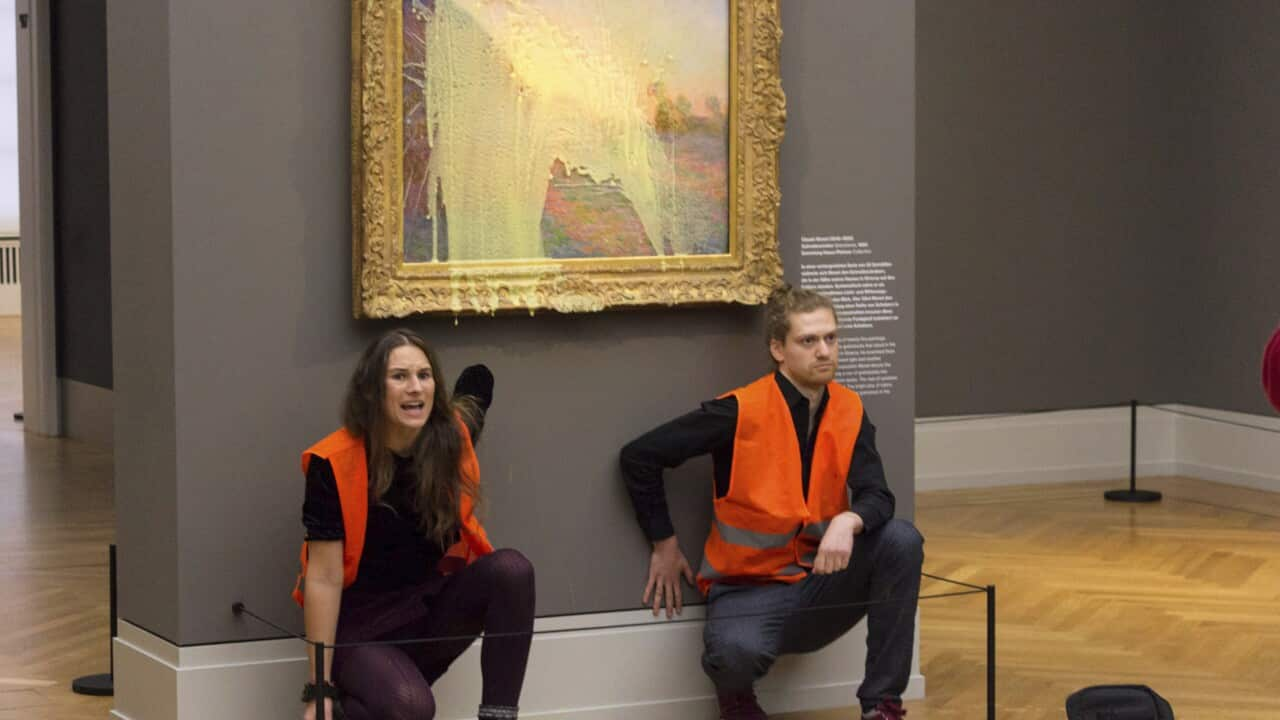Key Points
- Eco-activists have splashed mashed potatoes on a Claude Monet painting in a German museum
- It's the latest in a wave of protesters using art to make a point and they probably won't be the last.
Climate protesters have splashed mashed potatoes on a Claude Monet painting in a German museum, days after Vincent van Gogh's "Sunflowers" in London was hit by tomato soup.
Publishing a video of the action on Twitter, the environmental protest group Last Generation wrote: "If it takes a painting — with #MashedPotatoes or #TomatoSoup thrown at it — to make society remember that the fossil fuel course is killing us all: Then we'll give you #MashedPotatoes on a painting!"
The work, "Les Meules" (Haystacks), hangs in the Museum Barberini in Potsdam and is part of billionaire Hasso Plattner's collection. It is on permanent loan to the museum.
The painting fetched US$111 million ($174 million) at an auction in 2019 — the highest sum paid for a Monet.
Dressed in black with orange vests, the two activists poured the mashed potatoes on the painting before squatting in front of it and sticking a hand each on the wall.
"Does it take mashed potatoes on a painting to get you to listen? This painting is not going to be worth anything if we have to fight over food," said one of the two activists.
Both were taken into custody and are under investigation for damage to property and trespassing, police said.
The painting was protected by glass, the museum said, adding that experts have assessed that it has not suffered any damage.
The work will be back on show from Wednesday, the museum said.
In a similar stunt on 14 October, two environmental protesters hit van Gogh's world-renowned work with tomato soup at the National Gallery in London.
The gallery said the protesters caused "minor damage to the frame but the painting is unharmed".
Massacre in Korea by Picasso
Earlier this month, two Extinction Rebellion activists glued themselves to a prized Picasso painting at the National Gallery of Victoria in Melbourne before being removed from the gallery and arrested.
The group claimed they targeted this particular painting, titled "Massacre in Korea", because of its depiction of the “suffering of war”.
The pair also displayed a banner as part of the protest, which read: "Climate Chaos=War + Famine".
In a video posted on social media, one protester could be heard saying: "We'd prefer not to be doing this but desperate times call for desperate measures."
The painting itself was unharmed as the pair had only stuck their hands to the protective covering. But this isn’t the first-time high art has been targeted in the name of climate protests.
Mona Lisa by Leonardo Da Vinci
Earlier this year, a 36-year-old man disguised as an elderly woman smeared cake on the protective glass covering of Leonardo da Vinci's Mona Lisa at Louvre Museum.
Many believed this was a climate protest as the man was filmed yelling: "Think of the earth, people are destroying the earth" while being led away by security at the Paris gallery. The man was placed in psychiatric care following his arrest.

Credit: Twitter @klevisl007 via AAP
My Heart’s in the Highlands by Horatio McCulloch
In June, Just Stop Oil activists stuck themselves to Horatio McCulloch's My Heart’s in the Highlands which is currently on display in Glasgow’s Kelvingrove Art Gallery. Protesters made a connection between the 1860’s land clearings and the current climate uncertainty.
The Last Supper by Giampietrino
The UK-based group staged protests targeting works by Vincent Van Gogh, John Constable, and Giampietrino’s The Last Supper before other climate activists began replicating the stunt.
Italian-based climate activist group Ultima Generazione (Last Generation) used the demonstration tactic to promote the same message “Just Stop Oil” by sticking themselves to a series of statues in the following months.

Members of an Italian-based climate activist group stuck themselves to a series of statues. Credit: Just Stop Oil
Sistine Madonna by Raphael
German activists from the group Letzte Generation, which also translates to Last Generation, took part in the trend when they attached their hands to a 16th-century Raphael painting, Sistine Madonna. Protesters said they targeted the artwork because of its depiction of Jesus Christ facing death, adding that future generations are facing an “equally predictable death, will also be the result of climate collapse”.

German climate change activists stuck their hands to a 16th-century Raphael painting, Sistine Madonna. Credit: Letze Generation
“The activists are actually artists"
It's unclear whether the demonstrations inspired the Melbourne protest, but a multidisciplinary artist and University of Sydney art doctorate student Patrizia Biondi told SBS News in July that we may see similar stunts take place as “the need and urgency (for climate action) rises”.
Ms Biondi pointed out that these actions are often undertaken by artists themselves and that the demonstrations tend to be carefully executed to avoid damaging the artworks themselves.
“The activists are actually artists. And for an artist, there would be nothing more abominable than damaging an artwork,” she said.
Ms Biondi explained this wave of climate activism tends to focus their demonstrations on artworks that mimic the point they are trying to make.
“We need to be thinking about how this type of suffering will increase, and how the societal breakdown that scientists are telling us is coming will eventually put us all in the firing line," Extinction Rebellion said in a statement.









